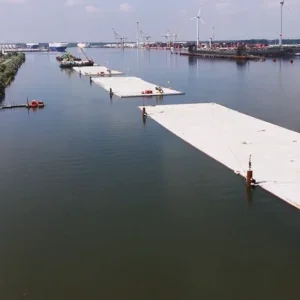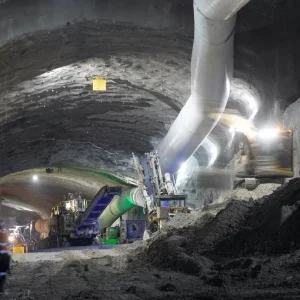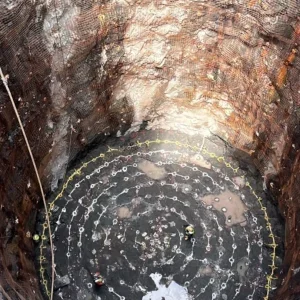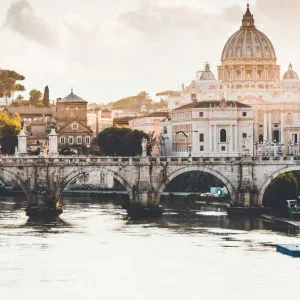The authors believe that Korea could be the country where the most tunnelling and underground projects are, or will be, performed in the world. Since over 65% of the Korean peninsula is mountainous terrain, railways, roads, and motorways can not avoid the incorporation of tunnels. Construction of intricate metro lines is currently underway across six major cities, with even more planned for the future to compensate for the ever increasing traffic. Moreover, several large underground oil and gas storage cavern projects are in progress. In metropolitan cities power lines, telecommunication lines and water-supply lines are installed within tunnels. This report will highlight the most challenging problems that have been encountered while designing and constructing tunnels in the Korean peninsula.
Geology
The predominant rock types in Korea are granite, granitic gneiss, and gneiss. In most cases, joints and fissures are abundant, making tunnel engineering all the more difficult. Faults are also frequently encountered. In some parts of the peninsula, sedimentary rocks and their metamorphic derivatives are also found.
As the dimensions of newly planned tunnels become longer and wider, the geology of the proposed site becomes a greater factor, demanding more complete, albeit complicated, site investigation plans. Nowadays, it is not uncommon to perform intensive geophysical surveys (such as seismic surveys, electrical surveys, etc.) besides borehole logging in the design stage of tunnels and underground structures.
Rail tunnels
After about a 30-year lull in construction of new railroads, Korea has become aware of the importance of railways for the mobilisation of material resources. As of such, railways construction projects have been on the increase for three years. The projects include construction of new railways, installation of double tracks for existing single-track railways and the repair of existing railways. In the construction of new railways, the incorporation of tunnels cannot be avoided. At present, an estimated 13 tunnels with a total length of 37km are under construction.
Among these tunnel projects, the most interesting project is the ‘Yongdong-son tunnel’, which has a tunnel length of 16.3km and will be the longest tunnel in Korea. The design has been completed and construction has just begun. The geology at this site is very complex; the tunnel must run through a fractured zone consisting of limestone, large faults and abandoned mines in the immediate vicinity.
The first high-speed railroad in the Korean peninsula is under construction starting from the Seoul metropolitan area to Pusan. The total length of the longest of the 60 tunnels is 9.98km, named the ‘Sangchon Tunnel’, which is also the longest high-speed railway tunnel in Korea, is located between Taejon and Taegu. This tunnel was constructed by NATM using the long bench cut method. The authors believe that during this large project, some new tunnelling technologies were adopted. First of all, for accurate surveying, the global positioining system (GPS) has been utilised. To assess the ground conditions ahead of the tunnel face, a horizontal pre-boring technique of up to 20m bore length was carried out. Robotics was employed for shotcreting. Tunnellers at this site employed all possible means to minimise the cycle time for tunnel excavation.
Fault zone
The Bokan Tunnel (located between Kyongju and Pusan) must run through the Yangsan fault, which is recognised as the largest fault in Korea. There has been much controversy among Korean seismologists over the possibility of activity within this fault. A thorough investigation programme was executed for the geological and geotechnical assessment of the site, one example being the electrical resistivity test. Based on results from this programme the tunnel support system as well as the excavation method has been fully revised.
Highway tunnels
Highways are constructed and maintained by the Korea Highway Corporation, and are the backbone of the transportation network in Korea. A total of 151 highway tunnels are under construction with a total length of 137km. Among them, the longest highway tunnel is the Jukreong Tunnel with a length of 4.52km.
The Jukreong Tunnel was constructed in two steps. The pilot tunnel was first constructed with a TBM with a diameter of 4m, and then a two-lane tunnel with a width of 10.7m was constructed by widening of the pilot tunnel. NATM was adopted for widening. For the prediction of the ground conditions ahead of the tunnel face, TSP surveying tests were performed more than 14 times.
Metro tunnels
In most of the large cities in the Korean peninsula, traffic is one of the most serious social problems. To solve this problem, mass transit transportation systems have been developed in the six largest cities in Korea: Seoul, Pusan, Taegu, Inchon, Kwangju and Taejon.
In the Seoul metropolitan area, the construction of the subway system consists of three phases. Phase I construction, which includes lines 1 to 4, was completed in 1985 with a total length of 116.5km. Phase II construction (total length of 168.4km), which includes lines 5 to 8, was due to be finished in November last year. Phase III (lines 9 to 12) is in the planning stage, and among them, line 9, which starts from Kimpo international airport and runs along the southern side of the Hahn river, is expected to undergo design and construction this year. The whole track of line 1 was constructed by the cut-and-cover method since this is the most economical means for construction at shallow depths. However, as the ever increasing severity of traffic at ground level prohibits extensive use of this method, subway construction is gradually changing from the cut-and-cover method to mined tunnelling. During Phase II construction, more than 60% of the subway tracks have been constructed by tunnelling.
Main issues
Metro tunnels are constructed at shallow depths. Double track metro tunnels are about 8.5m in height and 9.5m in width in the shape of a horseshoe. Since these relatively large tunnels are constructed at shallow depths, it is not unusual for tunnel crowns to extend into residual soils and even alluvial soils. In the Seoul metropolitan area, tunnel spring lines are usually located in highly weathered and/or moderately weathered rocks. In some cases, construction must be performed in ground conditions that can not be defined as either soil or rock, leading to difficulty in the selection of tunnelling method.
Metro tunnels in urban areas sometimes pass under the water table, so it is important to decide the drainage method and to analyse the influence of the seepage force acting on the tunnel lining.
An underwater tunnel can be designed either as a waterproof type or a drainage type according to the groundwater control methodology. In the waterproof type, the tunnel lining is designed to support the hydrostatic water pressure under the groundwater level; while with the drainage type, the tunnel lining is designed without consideration of the pore water pressure. In the latter case, it is presumed that the groundwater will flow into the filter located between the ground and the lining so that water pressure acting on the lining will not exist.
However, if the drainage tunnel is located under a river, the groundwater flow will show steady state flow conditions and ground earth pressure will exhibit an ‘effective stress + seepage pressure’ state with drainage. Sometimes, since the filter may not have sufficient drainage capacity, a residual water pressure will act on the lining.
The Seoul metro line 5 underpasses the Hahn River at two spans. The first span is a box structure constructed by the cut-and-cover method; and the other is a waterproof tunnel constructed by NATM. One layer of watertight membrane was installed to achieve a waterproof tunnel. However, due to defects in the membrane, water leakage through the concrete lining was encountered. To improve the water tightness, several new technologies are being adopted; for example, a double-layer watertight membrane system, installation of a water stop, use of watertight concrete lining etc.
Caverns
At present, five underground oil storage caverns and five underground LPG storage caverns have been completed and under operation. Moreover, additional caverns are undergoing construction, and more are in the planning stages. It goes without saying that hydraulic control is the most important issue regarding storage caverns. A data monitoring analysis system for underground highly pressurised gas storage facilities (MoGas) was developed in Korea (developed by the SK Construction Company). The program capabilities include design and database management of prevention of gas leakage from unlined, highly pressurised, gas storage caverns. This advanced system has been applied to several LPG caverns currently under operation.
Conclusion
Korea might be one of the countries where the largest amount of tunnelling and underground structure projects are performed. This report presents a summarised overview of these projects. Tunnelling in other areas such as power lines, telecommunication lines, etc. are beyond the scope of this report, although numerous projects concerning such tunnels are also in progress.
Tunnel construction in the Korean peninsula is not an easy task, for in many cases tunnels must run through residual soils and/or highly weathered rocks. The authors have been compiling their experience of tunnelling under difficult ground conditions that can not be defined solely as either soil or rock. Based on these efforts, the first national tunnel design guideline was recently established (Ministry of Construction, 1999). NATM is the most popular tunnelling technology in Korea; however, the usage of TBMs and the shield tunnelling method is increasing steadily.
Related Files
Sketch plan of the Yongdon-son Tunnel
Sketch plan of the Seoul metropolitan area
Cross-section through the Jukreong Tunnel







